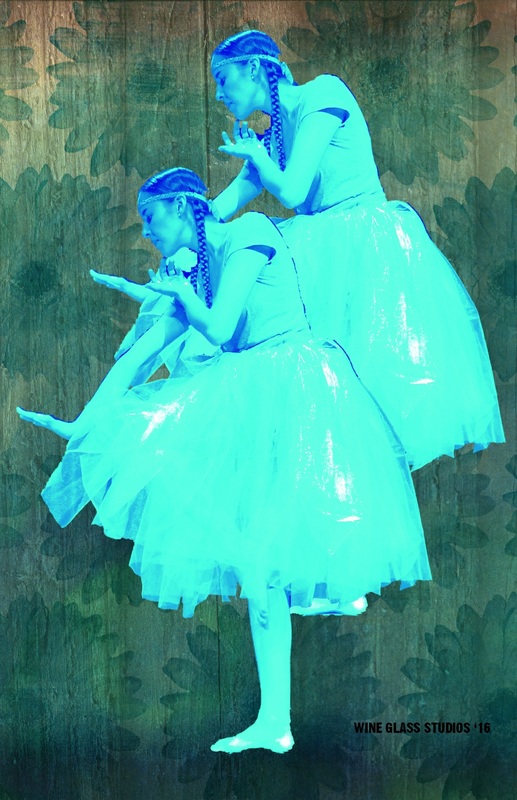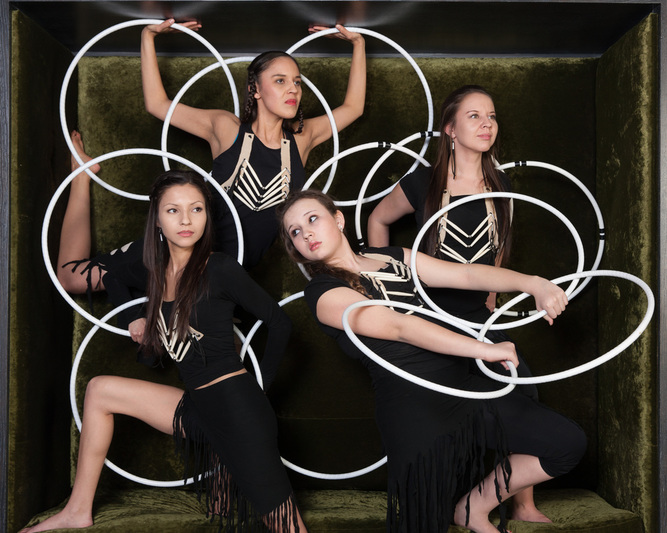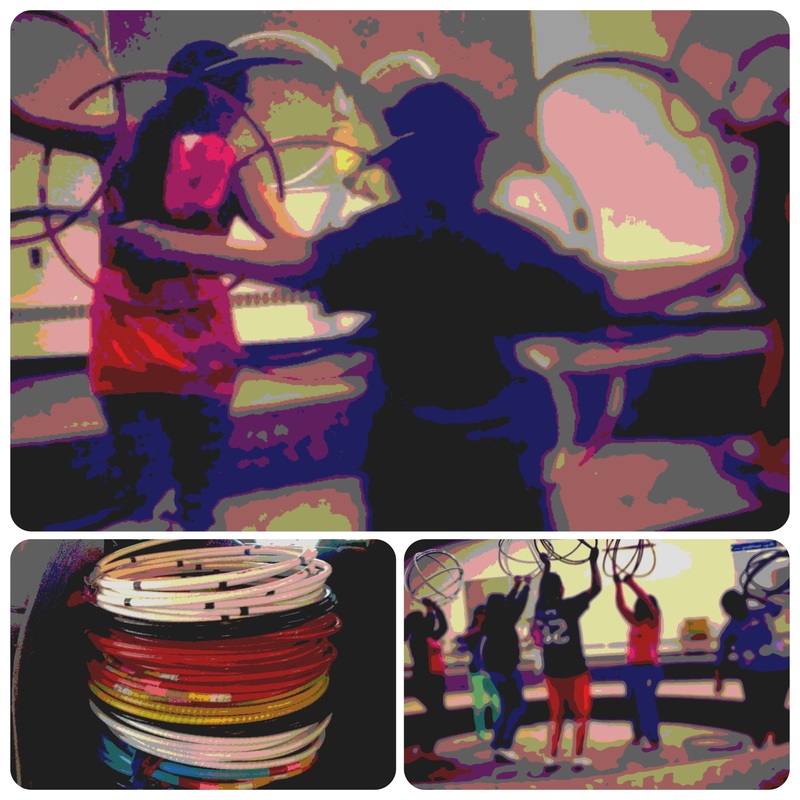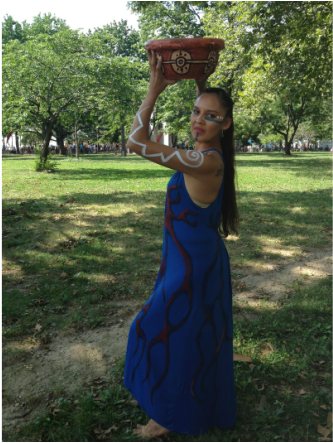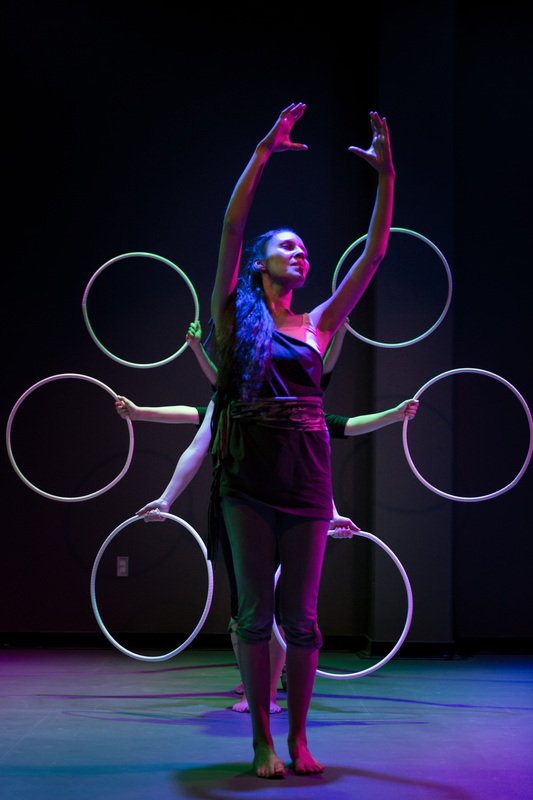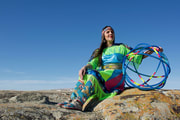|
“Not until we are lost do we begin to find ourselves” – Henry David Thoreau
This autobiographical solo uses Contemporary Indigenous Dance, hip hop, and hoop dancing to tell my story as a dancer and a Cree woman. The intent of this piece is to show how culture, story, and ceremony can guide towards healing in a post-colonial/ contemporary society. I believe healing is the first step on the path towards well-being and self-determination for First Nations communities and nations. To tell my story I use a tutu, hoodie, and hoops – that represent the three stages I have gone through as the title of the piece suggests: Nimihitow Iskwew (Dancing Woman): A Cree Woman’s Journey through Life and Dance. My mother first put me in tap and ballet classes because I was pigeon toed; this was my first experience with the healing power of dance. I continued in Western dance styles such as tap, jazz, ballet, lyrical and modern and eventually was chosen for solos. Even after spending years with the same group of girls several times a week in dance classes I never developed friendships. I was the only Native girl in the class and came from a large family with low income. I did not ‘fit’ the stereotype that mainstream society had envisioned of what dancer should be and look like. I quit dance altogether and found alternative, self-destructive, ways to fill the time that was once occupied by up to five dance classes a week, plus weekend solo work. I did not fit into mainstream identities and fell into expressions of identity that were often negative and stereotypical ideas of First Nations. It wasn’t until I learnt the hoop dance and contemporary Indigenous Dance that I found a healthy balance between my passion for dance and my identity. As I began to hoop dance I learnt many cultural stories and teachings. I began to live my life according to these traditions. This month I am celebrating eight years abstaining from alcohol and have been a professional hoop dancer since 2005. I began developing this piece in 2011 after studying the cycle of creation – destruction – and re-creation discussed by Anishnaabe (Ojibway) spoken word artist and scholar Dr. Leanne Simpson in her book “Dancing on our Turtle’s Back: Stories of Nishnaabeg Re-Creation, Resurgence, and a New Emergence” (2011). I use this resurgence theory in my piece 'Sagowsko', about the Anishnaabe hoop dance story, which you can read more about here. Although this project began to take shape five years, it has taken me until now to reach a point in my life where I am able to tell my story. I feel that I am where I need to be, or where I am meant to be. All aspects of my life are aligned including, my job, dance, family, and ceremonial life, so that I can fulfill my purpose in life, which is to create and promote culture and dance as a way towards well-being - spiritual, physical, emotional, and mental. The piece debuted at "Hip, Hoop, Hooray" in October 2015, for the 10th anniversary of learning the hoop dance. (See some of the other performances here: https://www.youtube.com/watch?v=d07Dm7ojtmg) I will be performing this solo piece for the Slave Lake Native Friendship Center (SLNFC) Youth Conference “Rekindling Your Spirit” March 18-20. I have also been invited to perform for the Lethbridge Society of Independent Dance Artists (LSIDA) fundraiser on April 2, 2016 at the CASA Lethbridge at 7pm, tickets $20. Please join us at either of these events, where I will be sharing my passion alongside other talented dancers!
2 Comments
Dancing Earth’s SEED Project held its first intensive with global Indigenous Ambassador artists in 2014. During that first year I learned that dancing on the land is a holistic experience, which includes the four directions and especially the four elements – wind, earth, fire and water. (Read more here)
In August of 2015 I was thrilled to be able to participate in the second summer dance intensive centered on the theme of ‘seeds’. A small group of alumni from the previous year participated in ‘land-dancing’ a term used by Artistic Director and Choreographer, Rulan Tangen, to describe her unique methodology for dance creation and movement. This process involved many instances of 'dancing into new territory' in a literal sense, such as bringing Indigenous dance into public spaces, private land, traditional Indigenous land, and colonized spaces. Dancers from last year’s intensive received training in how to teach Dancing Earth Methodology as we developed our own individual dance rituals, warm ups, and workouts. I was moved by the gesture of her gifting us with the tools and responsibility of sharing land- dancing techniques and Dancing Earth methodology with others across North America. I felt overwhelmed and incapable as I thought of sharing Indigenous contemporary dance and movement to people who may have no prior knowledge of Indigenous dance or culture. I imagined the reactions I might get. I imagined what others might say or think. Then it occurred to me that many of the Indigenous Choreographers I look up to have been doing this for decades. What would have it been like for them? Ten, twenty, thirty or more years ago to be one of only a handful of Indigenous dancers in North America or even in the world who practiced Indigenous contemporary dance. Before them we had our ancestors who carried on our dance practices, ceremonies, and songs when it was illegal. Facing imprisonment they kept dancing and practicing their culture resisting the attempts at outright extermination and assimilation of our peoples and cultures. Without these leaders we may not have any of the opportunities we have today. Once I returned home I reflected on the intensive and the new skills and tools I was able to develop in terms of teaching and facilitating dance. I was not sure if I would have a venue to utilize these new skills but I remained hopeful. Since the intensive I have found more opportunities to use dance at the school where I work. I have used these teaching techniques in our Dance & Storytelling program; one-on-one with students who have diverse needs, such as anxiety, anger, trauma, etc., I am now teaching a weekly class on dance, and I will also be returning to Physical Education classes to teach hoop dancing and other dances. I have been able to adapt what I learned in Santa Fe to the people and situations in my life, making dance relevant to each person, student, or class. This journey over the past six months reminds me of what my hoop dance teacher taught me about native culture – it is a living thing, always changing. Cree author and artist Floyd Favel says about Plains Cree philosophy: “Movement, in Cree, waskawewin, defines life. When somebody dies they stop moving, aponwaskawecik. If you asked "What is life?" A simple explanation using the Cree language would be that life is movement” (Forsythe). If we are using this fundamental belief of native philosophy in our dance practices, they will always change and evolve. In this way, we are always dancing into new territory. It is a humble remembrance to think of all the people who danced before us so that we could be here today. P.S. This summer I will be helping teach a First Nations Art and Dance Summer Camp, more information will be available soon, here: http://www.casalethbridge.ca/ James Forsythe . “THE PLAINS CREE GROTOWSKI”. Brandon University. http://www3.brandonu.ca/library/CJNS/21.2/cjnsv21no2_pg355-366.pdf Dancing Earth’s Website: http://www.dancingearth.org/ Travel Funding from Alberta Foundation for the Arts. On August 6, 2015 I was invited to the Pincher Creek Municipal Library to do a presentation for the summer storytelling program.
I choose to use dance and storytelling to share the Anishnaabe hoop dance story. I first learned this story almost ten years ago when I began hoop dancing. The full story along with many others can be found in Basil Johnston’s book The Manitous: The Spiritual Life of the Ojibway People. This story, like many First Nations stories, is timeless. The story is about Pukawiss, ‘the disowned one’, who was interested in creation and the natural world since he was a child. His father wished he would become a great hunter and warrior like his older brother, Maudjekawis. Pukawiss tried to be more like his brother, but would always return to his interest in nature and imitating animals around him. His father gave all his attention to his older brother and eventually Pukawiss became disowned and left his family. Pukawiss began to travel as a performer, dancer and choreographer becoming well known telling stories about life – love, hate, jealousy, etc. Eventually, he wanted to create a dance that showed all of life, the good and bad, so he created the hoop dance. Through the hoop dance we are taught about the struggles and triumphs in life. The beautiful designs reflect the beauty that is found all around us, such as birds, butterflies, flowers, etc. As the hoop dancer transitions from one shape to the next this shows that there are also struggles in life. The transition from one design to another also shows how everything in life is also interconnected, and the hoop itself represents interconnectedness, equality and balance. I think everyone can relate to Pukawiss’ journey and the burden of meeting the expectations of others. On a larger scale I think this story also shows the struggle of fitting into the roles that society and/or culture might assign to us. It is a powerful message for youth and young adults today to ‘be yourself’. Although, our skills, personality, or identity may not conform to the expectations that society and culture set forth we may find that we ‘fit in’ better when we are true to ourselves. I would like to dedicate this post to the memory and legacy of Basil Johnston who shared this story, and many others, in his books. Basil Johnston began his journey to the spirit world on September 8, 2015. He was a leader and inspiration with a profound knowledge of Anishnaabe culture, language and history. Miigwetch- Thank you! Photo Credit: Sally Turner, Pincher Creek Library This summer I was invited to represent Alberta First Nations at the Dance World Cup Opening Ceremonies and was a Delegate for the International Dance Council (CID) at the World Congress on Dance both held in Whistler BC, from July 3-5, 2015. This event hosted dancers and choreographer from around the world. The Dance World Cup was a competition and showcase of dancers, while the World Congress consisted of lectures, presentations, workshops and performances.
Sacred Dance and Storytelling This amazing opportunity to participate as the only First Nations dancer allowed me to learn other styles of dance from around the world and how they have evolved. Renu Sharma, from Mumbai, India, instructed a workshop on Kathak an Indian Classical Dance. She shared with us that the dance was originally done as a sacred dance only, but is now performed in public. This is similar to the hoop dance, which was traditionally only done as a healing ceremony, but today has evolved to be performed in public. Kathak is a storytelling dance, which again is also similar to the Hoop Dance, which is also a storytelling dance. The fact that these two Indigenous dance styles were originally ceremonial/ sacred dances and are also storytelling dances, suggests that storytelling and healing go hand in hand. Brain development research tells us that in order for us to make sense of and recover from a traumatic experience we need to reconcile the right (creative) and left (analytical) hemispheres of the brain. This requires telling a story that will appeal to both sides of the brain – rational and sequential, and at the same time, creative and emotional. This is something we can achieve through dance. When we dance from the heart, expressing our emotions, and at the same time tell our story, we are able to synthesize an experience to create healing. When we dance our stories we are able to create healing for ourselves and others. Dancing in the Four Directions Professor Patricia Torres of Mexico taught a workshop on Pre-Columbian dance. She shared that everything in the dance is done in fours and to the four directions. The dance begins around the drum in a clockwise direction, which represents the movement of the earth around the sun. Dr. Torres also shared that dance is taught by watching only. A workshop description of hers reads: Life enhancement through rituals. Our connection with others in the four corners of the world, the elements, the flavors of life all contained in our mathematical rhythms to feel the pulsations of the earth and our heart beating. Energy flow surrounding us and embracing all others in the circle. (www.malintzin.org) These teachings are similar to Hoop Dance teachings and powwow dancing. The hoop or circle is a sacred symbol that encompasses the four directions. Many Native dances from powwow and social dances to ceremonial dances are done clockwise, which follows the movement of the sun. These dances are also taught almost exclusively by watching only. When we dance in a circle and with the four directions we are dancing with the movement of the natural world. This helps us to understand and connect with the world around us. Learning by watching, helps us create our own awareness and discourse about what dancing is and what it means to us. In these ways we are creating our own story that is also interconnected with other stories. Daystar Rosalie Jones, says that: No one dancing Intertribal can dance only for technique, or only for ‘show’ or only for self. If it is anything at all, Intertribal Dance is the expression of the collective culture of the community, in its regalia, in its protocols and etiquettes, in its songs, and in the spirit present when one dances. (http://www.daystardance.com/value_indigenous_dance.html) I fully agree with her insight, but would add, by dancing with the movement of the earth, sun, and four directions we are also expressing the collective culture of the natural world and even the universe. This expression of collective culture can be interpreted as a form of storytelling. Dance is storytelling. It may tell a singular story, a collective story, or a universal story. Storytelling is an important part of healing, so dance your story and bring healing to yourself and the world! Thank you to the Alberta Foundation for the Arts- Cultural Relations Grant to help make this experience possible! Daystar Rosalie Jones. The Value of Indigenous Dance in Academia. http://daystardance.com/value_indigenous_dance.html The Brain Development information comes from a two hour presentation, for more information visit: http://www.albertafamilywellness.org/resources/video/how-brains-are-built-core-story-brain-development Patricia Torres. Pre-Columbian Dance Workshop. http://www.malintzin.org/index.php?option=com_content&view=article&id=110&Itemid=68 Patricia Torres. Intercultural Dance Workshop. http://www.tiahui.com.mx/ March 2015 provided me, my sisters, and niece the opportunity to perform my choreography of “Sagoswko”. The show has also been performed in Edmonton, AB; twice in Lethbridge, AB; with Trent University students in Peterborough, ON; and as a a solo in Toronto, ON. We performed one school show and two public shows for the International Festival of Animated Objects (IFAO) in Calgary, AB. The IFAO hosts artists from around the world who work with a variety of mediums such as puppets, masks, balloon art, film, and animation, to name a few.
Wanting to push the boundaries of what an ‘animated object’ is the festival producer, Xstine Cook, included our show as part of their line-up. This struck a chord with me because my own hoop dance teacher instilled the belief in me that the hoops, shapes, and animals represent spirit beings and therefore the hoops are not just objects, they are alive. This concept has been reinforced through other experiences with ceremony, dance, performance, and even in my education. In his "Tenets of Native Philosophy", Gregory Cajete, writes "Every 'thing' is animate and has a spirit" (65, Native Science: Natural Laws of Interdependence). The IFAO was my first real glimpse at the world of puppetry and animated objects. At the Dolly Wiggler Cabaret various artists involved in the festival performed short excerpts of their work. One of my favorite pieces were the "Dolly Wigglers" who did a performance piece called “Buffalo” in which they stated that “… the animated are not objects”. This echoed what I had already come to believe about the hoop dance, but this was in reference to puppets, masks and other animated objects. My perception of animated objects expanded and contracted at the same time. Expanding, as I realized that all these other artists who work with animated objects must have a strong connection with these ‘objects’ as we do as hoop dancers. I felt a connection to a whole other world of artists who work with animated objects. My perspective contracted as I realized how similar we are as artists working with animated objects. Although we may seem quite different, in terms of language, culture, and experience, etc. we are more similar than I realized. I felt close to the other artists through our shared experience as humans working with animated objects. The experience of the IFAO demonstrated the spirit of the hoops and how they are alive. They take me to places I may not go and show me things I would not normally see. Through the journey they take me on, the hoops teach me and show me the truths and teachings of interconnectedness and equality that they symbolize. My mom was at our show, which she often is, and she commented afterwards that she believed I am spiritually connected during the show, because she does not believe I am that good of an actress! (I took this as a compliment). She meant that it was a powerful performance and "pulls at the heart" so it must be a spiritual experience. It reaffirmed my passion and renewed my dedication to the hoop dance. The spirit of the hoop is alive and guiding a sacred journey. ‘Live in their breathing’, the creative potential of Land-Dancing, and the “Breath of Life”9/26/2014 August 2014 I travelled with my mother and six month old son to participate in the first half of Dancing Earth’s SEED project with Global Cultural Ambassador Artists representing 8 countries and 25 First Nations! I was invited to create a solo based on the theme “Origi-Nation: Roots and Seeds”.
My solo was inspired by Tomson Highway’s “Aria” and more specifically the monologue of ‘The Indian Woman’ which is written entirely in Cree. This playwright has been an inspiration on many levels for me throughout my life. This particular monologue has had a lasting impact on me because it captures so much of the beauty and wisdom inherent in Indigenous worldviews in a simple monologue. The translation of this monologue (which is not meant for audiences) is as follows: These trees So tall, straight I look at trees like this Inside of me – here – I feel someonew, a being Someone standing there Someone breathing there Spirit alive and living These trees Green so rich I want To talk to them Walk in them Breathe in them Live inside there breathing These trees (“Aria” Tomson Highway, Staging Coyote’s Dream: An Anthology of First Nations Drama in English, Ed. Monique Mojica and Ric Knowles, p. 88). The first time I read this I could see movement. Growing up in northern Alberta I was always surrounded by trees and forest, so, for me, trees are alive, they move, they speak, they dance… with air and wind, snow and rain, with sunlight, birds, squirrels, with us… I was expecting that creating a solo about trees while in New Mexico to be much more difficult than it actually was. We spent a lot of time outdoors at the various parks, landmarks, arroyos (a dry river bed that fills with water seasonally) and ancient pueblos (communal and/or dwelling structure used by tribes of the Southwestern United States). This proved to be a very informative experience for me – barefoot on the earth, sand sifting through my fingers, the heat of sunlight steadily rising and subsiding throughout the day, refuge inside a cave, wind whipping through hair and clothing, distant rain clouds or sudden downpours… All were blessings from above, below and around with the endless potential for creativity – seeds ready to be sown. We danced with the land and the land danced with us. We were there – witnessing, receiving, accepting, and connecting. The experience of land-dancing was inspiring in ways I cannot yet explain or grasp. My solo seemed to take on qualities of this experience. It begins began with a seed and the four elements of water, wind/ air, fire/ sunlight and earth. The seed then undergoes the transformation of growth becoming a tree that ‘grows straight and tall towards the creator’ (Anishnaabe teaching about Truth, via Marrie Mumford). The tree then becomes wind/ air and the breath that fills our lungs… and then transforming from wind/ air back into a tree. The four elements became a more important part of the solo than I had originally anticipated, and I believe this was because of the research and development that was done with the land. It gave me real experiences in the real world, which sparked a whole new level of creativity that our man made world can only dream of. There is so much more wisdom out there, outside, than we can ever appreciate. The solo “Live in their Breathing”, co-created and choreographed by Rulan Tangen (Dancing Earth) and myself, is about transformation and reciprocity between humans and trees, through breath and air. But it also goes beyond that and is also about connecting with our ancestors. The deeper meaning within the solo is that it is also a story about a tree that started to grow long ago and has exchanged air/ breath with our ancestors. Today we exchange air/ breath with that same tree that our ancestors exchanged breath with. So connecting with the tree is a way of connecting with our ancestors through breath and air. University of Alberta Professor, Cindy Blackstock, explains what her Gitksan people call “the breath of life”: “We have been given the ancestors’ teachings and the feelings and the spirit. We can do a couple of things with that. We can say that what we know is inadequate and that we’re not Indian enough and that we don’t know enough about it or we don’t want to pass it on. And we hold our breath and our people stop. Or you can nourish that breath. You can breathe in even deeper the knowledge of others and understand it at a deep level and then breathe it forward. That’s the breath of life’” (Karen Lincoln Michel, Maslow’ hierarchy connected to Blackfoot beliefs <lincolnmichel.wordpress.com>) When we speak about trees and the fact that we ‘Live in their Breathing’ it is not only a physical necessity and scientific truth, it also has spiritual and cultural repercussions… it is a call into action to use our breath, to speak out, to carry on our culture, and share our knowledge. So it is a lesson for all of us: Don't hold your breath… Just breathe… Travel Funding provided by Alberta Foundation for the Arts "Traditional Aboriginal Arts Grant" This July I was honored to teach hoop dancing for the Aboriginal Girls Leadership Circle hosted by the University of Alberta. The summer camp was focused on Cree language and culture, all the instructors were Cree women who also served as role models and mentors.
Dance does not belong to us, we belong to the dance, we belong to the circle...
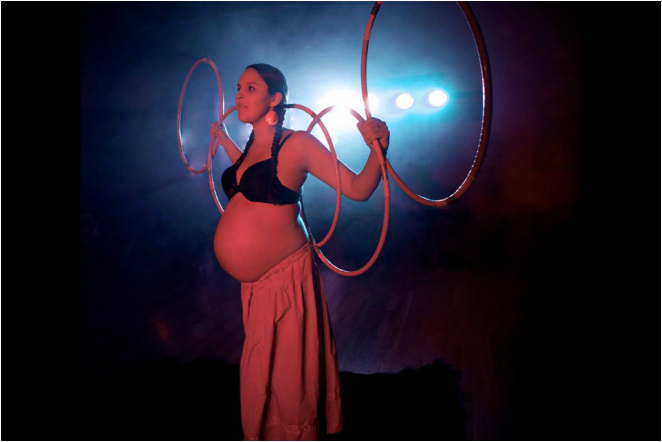 Photo: Young Medicine Photography Children are the meaning of life; Reflecting (on Dance): Dancing Earth brings “Walking at the Edge of Water” to New York City11/4/2013 In July- August 2013 I journeyed to the United States for my fourth time participating in a performance of Walking at the Edge of Water, choreographed by Rulan Tangen of Dancing Earth. We rehearsed in Santa Fe and performed two shows in New York City at the Downtown Dance Festival in Battery Park, sponsored by the Smithsonian Museum of the American Indian. There were ten dancers in the ensemble, and five of them I have worked with before (including Rulan) and it is always such an awesome experience to work with other Indigenous dancers. I would have to say this group is one of the best I have ever worked with, all being professional dancers, as well as, holders of traditional and spiritual knowledge and tradition. The way these dancers were brought together was nothing short of the universe flowing together in harmony. I believe we worked very well together and as a result were let out of rehearsal early on several occasions! (This in my experience is very rare) There were many instances where we came across signs that confirmed to us as a group and as individuals that we were meant to be here. We were destined to represent Indigenous dance next to dance companies from around the world, including NYC’s prestigious José Limón Company.
One of the first things we did upon arrival in NYC (after a red eye flight and a 6:00 am arrival) was visit the Two Row Wampum Gathering, which seeks honor for the original intention of the treaties, such as peace and sovereignty. The day before our arrival there was a march to the United Nations with hundreds of people who paddled canoes into NYC harbor in order to bring the message of the Two Row Wampum. The Two Row Wampum itself, which I had learnt about as a Graduate student with Dr. David Newhouse, represents two canoes paddling side by side along a river, neither interfering with the other’s vessel, but co-existing peacefully. This ideal had many implications and undertones relevant to our dance for the water. The river, canoes, peace and sovereignty is representative of many of the issues different Indigenous dancers have brought up over the years during the different explorations of Walking at the Edge of Water. When we arrived at the gathering we heard the Akwesasne Women Singers share a song for the water and the connection between women, birth and water. This is a theme we had heard from Anishnaabeg (Ojibway) women in Peterborough, Ontario during one of the first explorations creating dance around the theme of water. This was reflected for me in the fact that I was 15 weeks pregnant when we arrived in NYC, so my participation in Walking at the Edge of Water was especially compelling. In Anishnaabeg teachings water is also associated with emotions, such as those expressed through tears. I have been known to cry real tears on stage and backstage because of the emotional power in this dance. For me this was one of the most emotionally powerful performances of this show. Some of the Chiefs at the gathering spoke about the importance of water, and urged us to be aware of our impact on the water. An imminent and potent message as we sat next to the harbor where the canoes had paddled in and near the site where we would be dancing the next day to bring awareness to the issue. This was reflected in our performance through many images that depicted the harmful effects our actions have on water and the environment, such as oil, vanity, greed, and consumption. In a recent professional development opportunity, training in the’7 Habits of Highly Effective People’ we learnt about empathy. What we were taught was that reflecting is one of the highest forms of empathetic listening. The best way to show empathy towards others is reflecting back to them their words, thoughts and feelings. In this way we do not make assumptions, place judgement or focus on ourselves. We are simply reflecting what we hear or see. For me this resonated with my experiences in Walking at the Edge, of Water throughout this piece the dancers simply reflect... Reflecting water itself, reflecting Indigenous stories and teachings around water, reflecting how we all contribute to the destruction of water, reflecting the sacredness of water and the healing of water, thereby demonstrating the greatest form of empathy, one that makes no judgement or assumptions… And if the title of the training is accurate this is a ‘highly effective’ way to bring awareness to and show empathy for the sacred waters 'of our bodies and of the earth’ (as Rulan would say). We can only hope that this passion for the environment will continue to be reflected back to us through the people we meet, leaders that speak out, women that sing for the water, and is joined by the actions and voices of many more… Currently, I feel a great sense of pride as I follow Dancing Earth: Indigenous Contemporary Dance Creations on their tour to New Zealand, bringing this important dance and message to the world. You can read more about this journey at www.dancingearth.org or follow them on Facebook or Twitter. My participation was funded by the Canada Council for the Arts. Dancing Earth's U.S. dancers sponsored by the Smithsonian Museum of the American Indian in NYC. A few months ago my sisters and I were invited to be part of the Grand Opening of the brand new City of Lethbridge, Community Arts Center (CASA) consisting of a week-long celebration. Our collaborative, multi-disciplinary hoop dance performance titled, The Sacred Hoop, was on May 14, 2013.
The main piece in the show was Sagowsko (Bush Woman), a nickname given to me from my mother because I enjoy picking medicines in the forest. Sagowsko was inspired by the hoop dance story I was taught when I first started learning to hoop dance in 2005. It is a Nishnaabeg story and can be found in Basil Johnston’s book “The Manitous: The Spiritual World of the Ojibway”. The story is about Pukawiss, the disowned one, who was fascinated with nature. He became disowned by his father who wished he was more like his older brother a great hunter and warrior. Pukawiss leaves his family and does performances for different villages and eventually creates the hoop dance. This was the fourth time this piece has been performed and has continued to grow and evolve. We added a new opening scene that expressed the sacredness and strengths of Native women. This was followed by the exploration or discovery scene in which the main character, Sagowsko, is seen exploring in nature and mimicking the animals around her. The third scene is being lost and alone and represents the disconnection we have when we do not fit into the expectations of society. In this case Sagowsko was supposed to be picking berries like her sisters, but instead she wanted to explore the world around her. As a result she finds herself alone and lost… The final scene is about re-connection and the gift of the hoop dance. From being alone and afraid Sagowsko finds herself on the ground, where she very literally feels ‘the heartbeat of the earth’ and is able to re-connect with the world around her. The ‘hoop spirits’ enter and imbue her with their spiritual energies, the energies of creation… birds, butterflies, eagles and dance. It represents a sort of healing ritual one may experience when they are able to be themselves, to live in a connected way with their identity and the world around them. Through re-connection there is also a process of re-creation. Each time this piece has been performed it has brought audience members to tears, even though people comment that it is beautiful and uplifting. Sagowsko was very much an exploration of Resurgence Theory, which is a relatively new theory in Indigenous Knowledge although based in very ancient stories and traditions. This theory is explained by Dr. Leanne Simpson in her book, “Dancing on Our Turtles Back: Stories of Nishnaabeg Re-Creation, Resurgence, and a New Emergence” where she talks about the Seven Fires Prophecy of the Nishnaabeg. There are similar stories found in other First Nations cultures, including Blackfoot and Cree, although the details are slightly different. It often begins with conflict or war followed by a great flood and finally the re-creation of the earth by the ‘trickster’ (Waynabozhoo/ Weesagechak/ Naapi) with the help of the animals. Simpson explains that this is not a creation story, but a re-creation story. She describes it as a cycle of creation – destruction – re-creation found in Nishnaabeg thought. After interpreting the hoop dance story of Pukawiss through the lens of resurgence theory I began to see the cycle identified by Dr. Leanne Simpson as one of connection – disconnection – re-connection. This reflected the teachings of the hoop dance and represented the re-connection with identity and with the self, which is reflected in the story of Pukawiss and Sagowsko as well as in my own life. For me, it was the hoop dance that allowed me to find a re-connection with myself, my identity and the world around me. In the Nishnaabeg story a piece of earth is placed on the turtle’s back and, “Waynabozhoo began to sing. The animals danced in a clockwise circular fashion and the winds blew, creating a huge and widening circle. Eventually, they created the huge island on which we live, North America” (69). Dr. Simpson’s interpretation proclaims, “Together, we have all of the pieces. In Nishnaabeg thought, resurgence is dancing on our turtle’s back; it is visioning and dancing new realities and worlds into existence” (70). This was especially meaningful for me because inclusiveness and working together is embodied in the hoop itself. Also, the image of ‘dancing new realities and worlds into existence’ was re-affirming as a dancer and emerging choreographer, because I intentionally focus on healing and Nitonahk Miyo Pimadisiwin- Seeking a Good Life in my choreography. Dance is one of the ways that we can re-connect the sacred hoop which has been broken through colonization and assimilation as we re-create our reality to benefit all of creation. Hiy-hiy. This performance sponsored by the Allied Arts Council of Lethbridge. |
Nehiawsko Pikiskwew'Cree Woman Speaking' is a space to share my voice. My goal is to spread awareness and share wisdom as I learn and grow as a dancer, choreographer, and woman. My passion is to show the healing power of dance and culture. I love learning from elders, experience, and research and being able to synthesize Native and non-Native ways of knowing! Archives
November 2023
Categories
All
|
